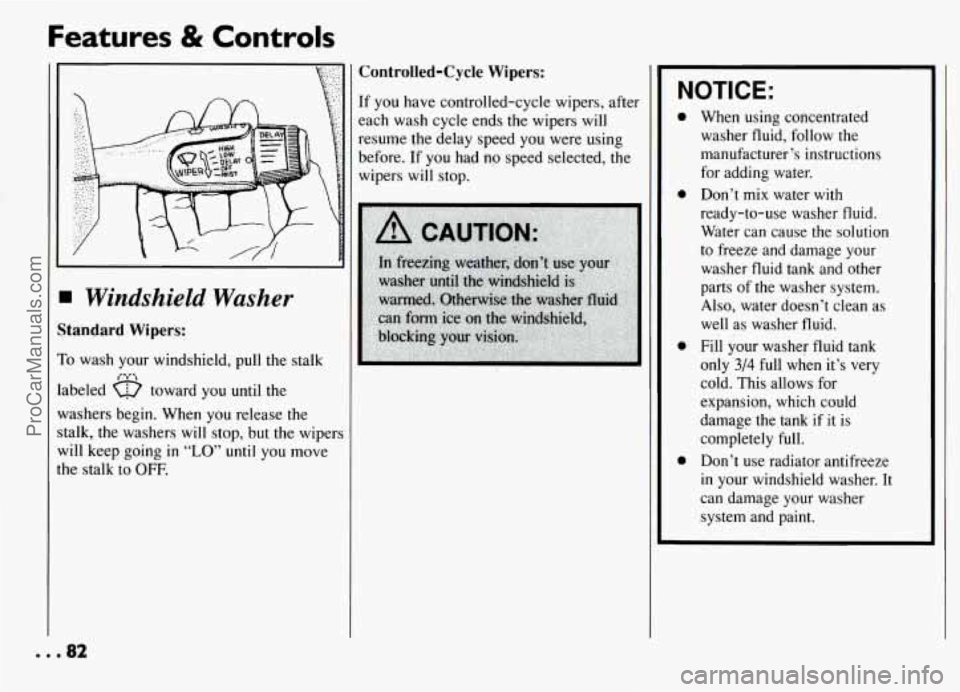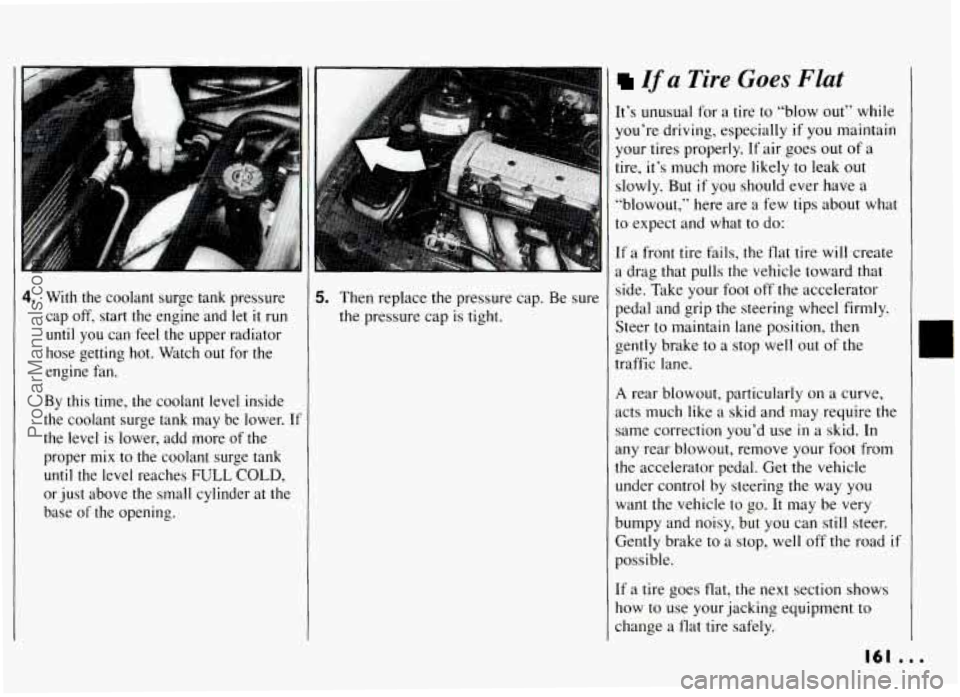Page 6 of 274
Vehicle Symbols
These are some of the symbols you may find on your vehicle.
For example,
these symbols
are used on an
original battery:
PROTECT
EYES BY
SHIELDING
CAUSTIC
BURNS
AVOID
SPARKS
OR
FLAMES
SPARK OR ,\I/,
COULD FLAME
EXPLODE BATTERY
These symbols
are important
for you and
your passengers
whenever your
vehicle is
driven:
DOOR LOCK
UNLOCK
FASTEN SEAT 4
BELTS
POWER
WINDOW
These symbols
have
to do with
your lights:
SIGNALS e
TURN
HIGH BEAM OR = =o
FOG LAMPS $0
These symbols
are
on some of
your controls:
WIPER Q
WINDSHIELD
WASHER
wlNDSHIELDw DEFROSTER
WINDOW REAR
DEFOGGER.
VENTILATING ca
FAN c.
These symbols
are used
on
warning and
indicator lights:
COOLANT F-
TEMP --
ENGINE
CHARGING BATTERY
SYSTEM
BRAKE (0)
RADIATOR a
COOLANT
FUEL
ENGINE OIL
PRESSURE
-4
TEMP OIL &
ANTILOCK (e)
BRAKE
Here are some
other symbols
you may
see:
FUSE *
RADIO
VOLUME
AIR
CONDITIONING
RELEASE TRUNK
LIGHTER
SPEAKER
b
ProCarManuals.com
Page 83 of 274

Features & Controls
Controlled-Cycle Wipers:
I Windshield Washer
itandard Wipers:
’0 wash your windshield, pull the stalk
abeled a toward you until the
Y-ashers begin. When you release the
talk, the washers will stop, but the wipers
vi11 keep going in “LO” until you move
he stalk to OFF.
,-i;
If you have controlled-cycle wipers, after
each wash cycle ends the wipers
will
resume the delay speed you were using
before. If you had no speed selected, the
wipers
will stop. ~
NOTICE:
0
0
0
0
When using concentrated
washer fluid, follow the
manufacturer’s instructions
for adding water.
Don’t
mix water with
ready-to-use washer fluid. Water can cause the solution
to freeze and damage your
washer fluid tank and other
parts of the washer system.
Also, water doesn’t clean as
well as washer fluid.
Fill your washer fluid tank
only
314 full when it’s very
cold. This allows for
expansion, which could
damage the tank
if it is
completely full.
Don’t use radiator antifreeze
in your windshield washer. It
can damage your washer
system and
paint.
..e82
ProCarManuals.com
Page 95 of 274

Features & Controls
Fuel Gage (CONT.)
0 It takes a little more or less fuel to fill
up than the gage indicated. For
example, the gage may have indicated
the tank was half full, but it actually
took a little more or less than half the
tank’s capacity to fill the tank.
0 The gage moves a little when you turn
a corner or speed up.
0 The gage doesn’t go back to “E” when
you turn off the ignition.
For your fuel tank capacity, see “Service
Station Information”
on the last page of
this manual.
Engine Coolant Temperature Warning
Light
This light tells you that your engine
coolant has overheated or your radiator
cooling fan is not working.
If you have been operating your vehicle
under normal driving conditions, you should pull
off the road, stop your vehicle
and
turn the engine off as soon as possible
HOT COOLANT CAN BURN YOU
BADLY!
In “Problems on the Road”, this manual
shows what to do. See “Engine
Overheating” in the Index.
Engine Coolant
Temperature Gage
This gage shows the engine coolant
temperature. If the gage pointer moves
into the red area, your engine is too hot!
That reading means the same thing as the
warning light. It means that your engine
coolant has overheated.
If you have been operating your vehicle
under normal driving conditions, you
should pull
off the road, stop your vehicle
and
turn off the engine as soon as possible.
HOT COOLANT CAN BURN YOU
BADLY!
In “Problems on the Road”, this manual shows what to do. See “Engine
Overheating” in the Index.
ProCarManuals.com
Page 159 of 274
Problems on the Road
1 Cooling System (CONK)
If the coolant inside the coolant surge
tank is boiling, don’t do anything else
until it cools down. The coolant level should be at or above
FULL COLD. If it isn’t, you may have a
leak in the radiator hoses, heater hoses,
radiator, water pump or somewhere else
in the cooling system. ~~~
NOTICE:
Engine
damage from running your
engine without coolant isn’t covered
by your warranty.
If there seems to be no leak, check to see
if the electric engine fan is running. If the
engine is overheating, the fan should be
running. If it isn’t, your vehicle needs
service.
e e e 158
ProCarManuals.com
Page 160 of 274
How to Add Coolant to the
Coolant Surge Tank
If you haven’t found a problem yet, but
the coolant level isn’t at or above
FULL
COLD,-add a 50/50 mixture of clean
water (preferably distilled) and a proper
antifreeze
at the coolant surge tank, but be
sure the cooling system, including the
coolant surge tank pressure cap, is cool
before
you do it. (See “Engine Coolant”
in the Index for more information about
the proper coolant
mix.)
NOTICE:
In cold weather, water can freeze
and crack the engine, radiator,
heater core and other
parts. So use
the recommended coolant.
L
159...
ProCarManuals.com
Page 161 of 274
Problems on the Road
..
How to Add Coolant to the
Coolant Surge Tank
(CONK)
1. You can remove the coolant surge
tank pressure cap when the cooling
system, including the coolant surge
tank pressure cap and upper radiator
hose, is no longer hot. Turn the
pressure cap slowly about one-quarter
turn to the left and then stop.
If you hear a hiss, wait for that to stop.
A hiss means there is still some
pressure left.
2. Then keep turning the pressure cap
slowly, and remove it.
. Once the pressure cap is off, look
inside the surge tank opening and look
for a small cylinder at the base
of the
opening. This should be covered with
coolant. If the cylinder
is uncovered,
the coolant
in your system is low.
Fill the coolant surge tank with the
proper mix, up to FULL COLD, or
just above the small cylinder at the
base
of the opening.
... 160
ProCarManuals.com
Page 162 of 274

7
4. With the coolant surge tank pressure
cap off, start the engine and let
it run
until you can feel the upper radiator
hose getting hot. Watch out for the
engine fan.
By this time, the coolant level inside
the coolant surge tank may be lower. If
the level is lower, add more
of the
proper
mix to the coolant surge tank
until the level reaches FULL COLD,
or just above the small cylinder at the
base
of the opening.
I
5. Then replace the pressure cap. Be sure
the pressure cap is tight.
If a Tire Goes Flat
It’s unusual for a tire to “blow out” while
you’re driving, especially
if you maintain
your tires properly. If air goes out
of a
tire, it’s much more likely to leak out
slowly. But if you should ever have a
“blowout,” here are
a few tips about what
to expect and what to do:
If a front tire fails, the flat tire will create
a drag that pulls the vehicle toward that
side. Take your foot off the accelerator
pedal and grip
the steering wheel firmly.
Steer to maintain lane position, then
gently brake to
a stop well out of the
traffic lane.
A rear blowout, particularly on a curve,
acts much like a skid and may require
the
same correction you’d use in a skid. In
my rear blowout, remove your foot from
the accelerator pedal. Get the vehicle
under control by steering the way you
want the vehicle to go. It may be very
wmpy and noisy, but you can still steer.
Sently brake to a stop, well off the road if
Jossible.
[fa tire goes flat, the next section shows
low to use your jacking equipment to
:hange a
flat tire safely.
161 ...
ProCarManuals.com
Page 189 of 274

Service & Appearance Care
How to Check:
The proper fluid should be added if the
level is at or below the STEP mark on the
reservoir cap. See the instructions on the
reservoir cap.
Engine Coolant
The following explains your cooling
system and how to add coolant when
it is
low.
If you have a problem with engine
overheating, see “Engine Overheating”
in
the Index,
The proper coolant for your Pontiac will:
Give freezing protection down to
-34°F (-37°C).
Give boiling protection up to 262°F
( 128 “C).
Protect against rust and corrosion.
Help keep the proper engine
temperature.
Let the warning lights work as they
should.
What to Use
Use a mixture of one-half clean water
(preferably distilled) and one-half
antifreeze that meets “GM Specification
1825-M,” which won’t damage aluminum
parts.
You can also use a recycled coolant
conforming to GM Specification 1825-M
with a complete coolant flush and refill. If
you use this mixture, you don’t need to
add anything else. NOTICE:
If you use an improper coolant mix,
your engine could overheat and be
badly damaged. The repair cost
wouldn’t be covered by your
warranty. Too much water
in the
mix can freeze and crack the engine,
radiator, heater core and other parts.
... 188
ProCarManuals.com